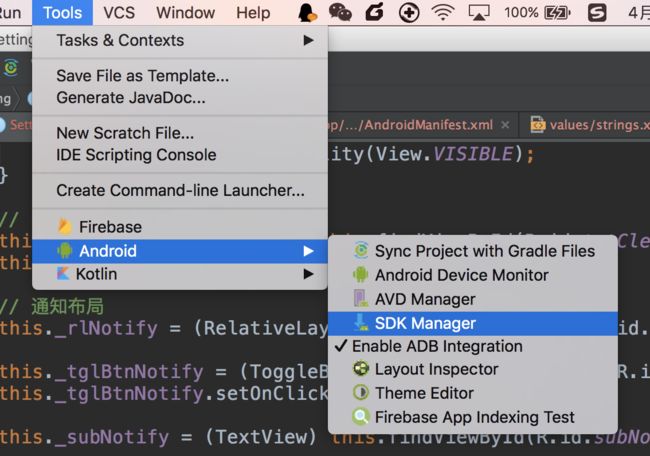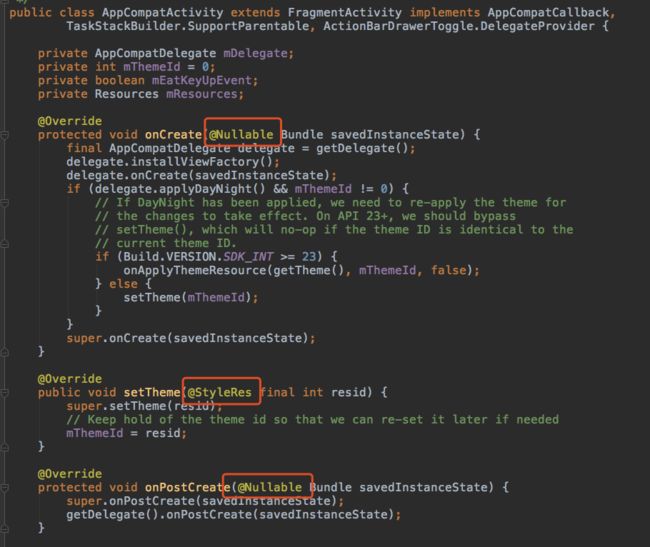注解支持的版本
Android support library从19.1版本开始就引入了一个新的注解库。
添加支持注解库依赖项
要在您的项目中启用注解,请向您的库或应用添加 support-annotations 依赖项。
支持注解库是Android 支持库的一部分。要向您的项目添加注解,您必须下载支持存储库并向 build.gradle文件中添加 support-annotations依赖项。
添加支持注解库依赖项
1,打开 SDK 管理器,方法是点击工具栏中的 SDK Manager或者选择 Tools > Android > SDK Manager;
2,点击 SDK Tools 标签;
3,展开 Support Repository 并选中 Android Support Repository 复选框;
4,点击 OK;
5,将以下代码行添加到 build.gradle 文件的 dependencies 块中,向您的项目添加 support-annotations 依赖项:
dependencies { compile 'com.android.support:support-annotations:24.2.0' }
6,Sync Now;
PS:
如果您使用appcompat库,则无需添加support-annotations依赖项。因为 appcompat库已经依赖注解库。
那有关注解的环境配置就已经构建好了,那接下来就是创建自己的注解的时候了。
介绍注解
在实现自己的注解时,我们需要来了解其中两个注解。
@Retention(RetentionPolicy.*)
Retention,保存策略。传入的RetentionPolicy参数有如下三种:
package java.lang.annotation;
/**
* Annotation retention policy. The constants of this enumerated type
* describe the various policies for retaining annotations. They are used
* in conjunction with the {@link Retention} meta-annotation type to specify
* how long annotations are to be retained.
*
* @author Joshua Bloch
* @since 1.5
*/
public enum RetentionPolicy {
/**
* Annotations are to be discarded by the compiler.
*/
SOURCE,
/**
* Annotations are to be recorded in the class file by the compiler
* but need not be retained by the VM at run time. This is the default
* behavior.
*/
CLASS,
/**
* Annotations are to be recorded in the class file by the compiler and
* retained by the VM at run time, so they may be read reflectively.
*
* @see java.lang.reflect.AnnotatedElement
*/
RUNTIME
}
PS:
1,SOURCR:只在*.java源文件的时候有效;
2,CLASS:只在*.java或者*.class中的文件有效,但是在运行环境无效;
3,RUNTIME:包含以上两种,并且运行时也会有效果,一般我们都会选用该参数。
@Target(ElementType.*)
Target,注解的目标类型。传入的ElementType类型有如下几种:
package java.lang.annotation;
/**
* A program element type. The constants of this enumerated type
* provide a simple classification of the declared elements in a
* Java program.
*
* These constants are used with the {@link Target} meta-annotation type
* to specify where it is legal to use an annotation type.
*
* @author Joshua Bloch
* @since 1.5
*/
public enum ElementType {
/** Class, interface (including annotation type), or enum declaration */
TYPE,
/** Field declaration (includes enum constants) */
FIELD,
/** Method declaration */
METHOD,
/** Formal parameter declaration */
PARAMETER,
/** Constructor declaration */
CONSTRUCTOR,
/** Local variable declaration */
LOCAL_VARIABLE,
/** Annotation type declaration */
ANNOTATION_TYPE,
/** Package declaration */
PACKAGE,
/**
* Type parameter declaration
*
* @since 1.8
* @hide 1.8
*/
TYPE_PARAMETER,
/**
* Use of a type
*
* @since 1.8
* @hide 1.8
*/
TYPE_USE
}
PS:
1,TYPE:作用于接口、类、枚举、注解;
2,FIELD:作用于成员变量(字段、枚举的常量);
3,METHOD:作用于方法;
4,PARAMETER:作用于方法的参数;
5,CONSTRUCTOR:作用于构造函数;
6,LOCAL_VARIABLE:作用于局部变量;
7,ANNOTATION_TYPE:作用于Annotation。例如如下代码:
@Documented
@Retention(RetentionPolicy.RUNTIME)
@Target(ElementType.ANNOTATION_TYPE)
public @interface Retention {
RetentionPolicy value();
}
8,PACKAGE:作用于包名;
9,TYPE_PARAMETER:java8新增,但无法访问到;
10,TYPE_USE:java8新增,但无法访问到;
下面做个DEMO,用注解来做以下两件事:
1,查找控件;
import java.lang.annotation.ElementType;
import java.lang.annotation.Retention;
import java.lang.annotation.RetentionPolicy;
import java.lang.annotation.Target;
/**
* 根据ID查看View的注解 2017/4/14 08:54
*/
@Target(ElementType.FIELD)
@Retention(RetentionPolicy.RUNTIME)
public @interface FindViewById {
// 使用value命名,则使用的时候可以忽略,否则使用时就得把参数名加上 2017/4/14 08:57
int value();
}
2,设置点击事件;
import java.lang.annotation.ElementType;
import java.lang.annotation.Retention;
import java.lang.annotation.RetentionPolicy;
import java.lang.annotation.Target;
/**
* 设置点击事件 2017/4/14 09:20
*/
@Target(ElementType.FIELD)
@Retention(RetentionPolicy.RUNTIME)
public @interface SetOnClickListener {
int id();
String methodName();
}
PS:
1,变量命名,使用value命名,则使用的时候可以忽略,否则使用时就得把参数名加上,所以我在两个注解上分别使用了不同的变量方式,下面使用的时候,大家记得看清楚。
使用自定义注解
1,在布局文件添加Button,如下:
2,在Activity中,申明Button变量以及click方法,如下:
@FindViewById(R.id.btnSay)
@SetOnClickListener(id = R.id.btnSay, methodName = "click")
private Button _btnSay;
/**
* 点击事件 2017/4/14 10:00
*/
public void click() {
Toast.makeText(this, "Hello world", Toast.LENGTH_SHORT).show();
}
3,创建注解解析器,代码如下:
import android.app.Activity;
import android.view.View;
import java.lang.annotation.Annotation;
import java.lang.reflect.Field;
import java.lang.reflect.Method;
/**
* Annotation解析 2017/4/14 09:00
*/
public class AnnotationParse {
/**
* 解析 2017/4/14 09:01
* @param target 解析目标
*/
public static void parse(final Activity target) {
try {
Class clazz = target.getClass();
Field[] fields = clazz.getDeclaredFields(); // 获取所有的字段 2017/4/14 09:34
FindViewById byId;
SetOnClickListener clkListener;
View view;
String name;
String methodName;
int id;
for (Field field : fields){
Annotation[] annotations = field.getAnnotations();
for(Annotation annotation:annotations) {
if (annotation instanceof FindViewById) {
byId = field.getAnnotation(FindViewById.class); // 获取FindViewById对象 2017/4/14 09:10
field.setAccessible(true); // 反射访问私有成员,必须进行此操作 2017/4/14 09:13
name = field.getName(); // 字段名 2017/4/14 09:18
id = byId.value();
// 查找对象 2017/4/14 09:15
view = target.findViewById(id);
if (view != null)
field.set(target, view);
else
throw new Exception("Cannot find.View name is " + name + ".");
} else if (annotation instanceof SetOnClickListener) { // 设置点击方法 2017/4/14 09:59
clkListener = field.getAnnotation(SetOnClickListener.class);
field.setAccessible(true);
// 获取变量 2017/4/14 10:00
id = clkListener.id();
methodName = clkListener.methodName();
name = field.getName();
view = (View) field.get(target);
if (view == null) { // 如果对象为空,则重新查找对象 2017/4/14 09:45
view = target.findViewById(id);
if (view != null)
field.set(target, view);
else
throw new Exception("Cannot find.View name is " + name + ".");
}
// 设置执行方法 2017/4/14 09:55
Method[] methods = clazz.getDeclaredMethods();
boolean isFind = false;
for (final Method method:methods) {
if (method.getName().equals(methodName)) {
isFind = true;
view.setOnClickListener(new View.OnClickListener() {
@Override
public void onClick(View v) {
try {
method.invoke(target);
} catch (Exception e) {
e.printStackTrace();
}
}
});
break;
}
}
// 没有找到 2017/4/14 09:59
if (!isFind) {
throw new Exception("Cannot find.Method name is " + methodName + ".");
}
}
}
}
} catch (Exception e) {
e.printStackTrace();
}
}
}
PS:
上面的注解解析器注释比较详细,仔细看下,应该就可以读懂上面的解析器作用。它大概做了以下几个事情:
a,通过field.getAnnotation(FindViewById.class);反射获得FindViewById注解对象,进而得到我们设置的参数值R.id.btnSay,再通过Target对象去查找控件,并设置;
b,同1,SetOnClickListener也是这样设置,只不过多了一个通过反射获得的方法,并调用的过程;
c,field.setAccessible(true);一定要设置,因为反射访问的是私有成员变量,不设置会报异常;
4,调用
在OnCreate()方法中,如下调用:
// 解析注解 2017/4/14 09:22
AnnotationParse.parse(this);
this._btnSay.setText("CCB"); // 只是做下改变
5,演示效果
总结
总上面的注解解析器中,可以看得出来注解Annotation往往是跟反射配合起来使用的,就连Android现在都很多地方使用到了注解,例如AppcompatActivity类:
就写框架的人也常说,无反射,不框架,那现在其实也可以说,无反射,不注解。
所以,要想自己有所进阶,学会创建使用自己的Annotaion就是基础中的基础了。
跟着上面的思路走,那么就应该能正常理解并使用Annotation库了.



